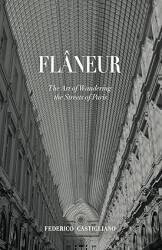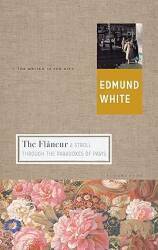
The Art of Flânerie
Breakfast, Coffee, and the Market
The flâneur
strolls as an acute observer of society.
The idea of the activity
flânerie as
strolling or idling dates to the 16th or 17th century,
often referring to wasting time.
But writers in the 19th century, especially Charles Baudelaire,
developed a rich set of honorable interpretations of the
flâneur and flânerie.
Here is some further aimless wandering in Paris.
I started with a relatively early breakfast
along Boulevard de Rochechouart.
This is just up Rue de Dunkerque from where I was staying
at the Vintage Hostel.
There's a nice view up the butte of Montmartre,
and plenty of busy foot and vehicular traffic to watch.


The standard French breakfast — croissant et café. It's accompanied by a small glass of water and a cookie.

The French term is petit déjeuner, the "small lunch". It came from a Latin word meaning "to break the fast". So, English uses the same meaning, but this is a case where English doesn't use a modernized version of the Norman French words that invaded in 1066.

I paid, leaving a pourboire or "for the drink" for the waiter. Meanwhile the commuters continued on bicycles and scooters.

It was time to move on. To... well... nowhere in particular. Wherever the streets led me.

I am at the next corner up the street from where I was staying. I had spotted an interesting item that I had not yet noticed, despite walking past here several times a day since my arrival. This is why you do flânerie, to notice the things you might have passed multiple times without seeing them. The flâneur tries to take it all in. There's a very small plaque on the corner of the building.
French Resistance MemorialsAdolphe Petrement, a veteran of the First World War, was killed here on 24 August 1944 fighting in the Second World War with the FFI, the Free French forces. The German garrison surrendered the next day, the 25th, and Paris was liberated after 50 months of occupation.

A Little More Café
Continuing down past the Vintage Hostel, I came to La Royale bar-café-tabac. A tabac almost always has some form of a red double-cone sign.

There's a metal bar top, an espresso machine, all the standard fixtures.

The tabac is a French institution. There is a rack of tobacco in the background of the picture above, but today most people stop for coffee, or a small glass of wine or calvados. Then they can study the racing news, catch up on football results, or try their luck with a lottery ticket.

Around the Neighborhood
Now I was ready for some wandering. A large school is in a nearby side street.


lunch menus
As required by law, the week's menu is posted out front. The larger one at bottom shows the menus, the set meals for lunch. Lamb on Tuesday, fish on Wednesday, duck on Thursday, then vegetarian Friday. Schools, along with post offices, libraries, and all other government facilities, are closed on Monday as it's Pentecost Monday.
The upper sheet lists goûters élémentaires or "simple snacks". Cheese, fruit, yogurt, no bags of highly processed chips.
And, as at every school I remember seeing in Paris, there is a memorial to the students who were transported to the German death camps with the help of the Vichy government. There were more than 300 just from the 9th arrondissement.


Now I'm finally wandering downhill toward Gare du Nord, as per the supposed "plan" I had concocted while having breakfast. I passed a very nice fruit and vegetable shop.



Past Gare du Nord
Gare du Nord is one of the six large terminus railway stations in Paris. As its name indicates, it provides train service to northern France. It also has international rail connections — Eurostar to London, and the French SNCF and Belgian Thalys to Belgium, the Netherlands, and Germany.
Mons, BelgiumI had arrived here several days ago. I had been teaching a one-week cybersecurity course to NATO in Belgium. The class ended Friday afternoon. I arrived in Paris that evening on a Belgian Thalys express train.

With all the French workers commuting in every day from suburban and regional homes for work in Paris, over 220 million passengers pass through this station each year. That makes it the busiest railway station in Europe, by number of passengers.
A station was built here in 1846. That was partly demolished in 1860 to provide space for what evolved into the current station through a series of several modifications and expansions.
Through the Market
From Gare du Nord I walked south-east down Boulevard de Magenta, which passes diagonally near the main façades of both Gare du Nord and Gare de l'Est.
Between the two stations I came to Marché Saint-Quentin, built of pink bricks and covered by an iron framework. It's one of the city's oldest market buildings, constructed soon after the boulevard's completion.

I first came to one of several cheese shops.

Then, one of several seafood shops.

The butcher has both beef and veal.
The Normans of northern France, originally Northmen or Norsemen, invaded Britain and seized power in England in 1066. The French-speaking Normans ruled, and the Anglo-Saxon people who were already living in southern Britain did the work.
The Anglo-Saxon peasants took care of cows, and chickens, and sheep.
The Norman rulers ate boeuf and veau, poulet, and mouton, later pronounced as beef and veal, pullet, and mutton.
So, in modern English, animals with Anglo-Saxon-derived names are turned into food with French-derived names.

You can get couscous and tajine just like in Marseille, and on across the Mediterranean in north Africa. Eat in, or carry out. To decode the sign, a traiteur is a caterer, emporter is to carry out.

This restaurant has food from sub-Saharan Francophone Africa.

And, more seafood...

...and more cheese.


A boulangerie has a variety of whole-grain breads.

And, one last seafood array on my way out.

The Neighborhood Electrical Substation
Paris is the City of Light, and it takes plenty of electricity to make that happen. Here's the Magenta neighborhood distribution station.

France has plenty of electricity, with over 80% of it generated by nuclear power, the highest percentage in the world. Électricité de France, the main producer, is the second-largest electric utility in the world. It operates world-wide, including EDF Inc in the United States, where it fully controls Unistar Nuclear Energy, EnXco, EDF Trading North America, and has a 50% interest with Exelon in Constellation Energy Nuclear Group. Unistar operates four nuclear power plants in the eastern United States. EnXco builds and operates wind and solar electrical power projects across the U.S.
In the U.S., the majority of electrical power comes from coal and gas. French citizens don't use as much of it as Americans, on a per-capita basis. Just about 8,000 kWh versus 13,000 kWh.

Magenta
I continued southeast down Boulevard de Magenta. Emperor Napoléon III, the nephew of Napoléon Bonaparte, made Georges-Eugène Haussmann the Prefect of Seine from 1853 to 1870, and charged him with carrying out a massive urban renewal program.
The street plan in much of Paris had changed little since the Middle Ages. Haussmann was to open things up, connect and unify different parts of the city, and make it more beautiful. Boulevard de Magenta is one of the many large Haussmann boulevards. He had this boulevard in his plan, but it was simply called "boulevard du Nord", running to the Paris-Nord railway station.
Italy still wasn't a unified nation, it was a large peninsula with a large number of squabbling city-states, petty kingdoms, and foreign intrigue. Part of that foreign intrigue was the French "Army of Italy", a field army of the French Army, stationed on the Italian border and used for operations in Italy itself.
The Battle of Magenta was fought on 4 June 1859 in the Kingdom of Lombardy-Venetia, controlled by the Austrian Empire. The Piedmontais of the Kingdom of Piedmont-Sardinia were the nominal Italian victors, but the French forces did almost all of the fighting. Just 1,100 of the French-Piedmontese coalition were Piedmontese, 58,000 were French.
So, the boulevard, being built in 1855-1859, was renamed to commemorate the military victory.
There are historic sights all along the boulevard. #4 contains the former home of Jacques Bonsergent, the first of many Parisians shot by the occupying Germans during World War II. #24 was the home of the restaurant Véry, where the anarchist Ravachole was arrested in 1892. A few weeks later, the anarchists set off a bomb there, in revenge against the restaurant owner who had reported him to the police.
The Labor Exchange
At the southeast end of Boulevard de Magenta I reached Place de la République. That location used to be called Château d'Eau, as it was the site of a large water tank.
I turned almost 360° to head northwest on the much smaller rue Château d'Eau. That took me past the Bourse du Travail or the Labor Exchange. It's definitely an anti-Fascist group. There's no nonsense here about the Nazis being "very fine people".



Sapeurs-Pompiers
The sapeurs-pompiers or the Fire Brigade, literally the Sappers and Pumpers, have a station a few blocks past the labor hall.

The sapeurs-pompiers are all the emergency services rolled into one.

Lunch, then Cidre
I had been wandering long enough that it was time to get lunch. A café at the northwest end of rue Château d'Eau had a menu or lunchtime fixed meal of salade, croque-monsieur, et frîtes.
The croque-monsieur, French for "Mister Crunch", is a sandwich of sliced boiled ham and sliced cheese, topped with grated cheese, then baked in an oven or fried in a pan. It's standard simple bar food.


Then I crossed over to the Café Le Château d'Eau where I had been before, to have a Normandy cidre and watch the neighborhood activity.



And on to the next adventure
ParisMegaliths
It was early afternoon. Plenty of time to take the Métro to Gare Montparnasse, then the Transilien suburban train to Meudon. A 19th century archaeologist had transported a Neolithic dolmen from Brittany to the outskirts of Paris, to serve as his family tomb. It was in a cemetery there. Plus, there was a megalithic passage grave in a nearby park, close to the Paris Observatory.
There are always things to interest the curious flâneur.


